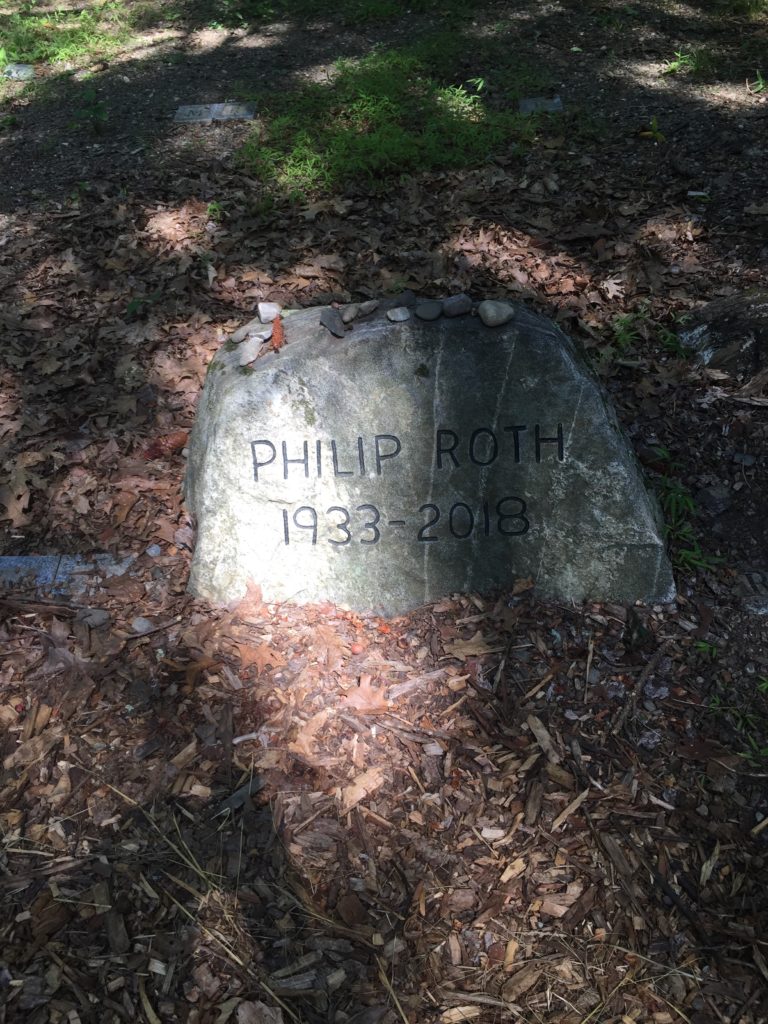Erik Visits an American Grave, Part 705
This is the grave of Philip Roth.

Born in 1933 in Newark, Roth’s childhood is fairly well known because he drew on it so extensively in his books. He grew up in that mid-century Jewish world of upward mobility but with a strong connection to the immigrant culture of his time. His parents were born in the U.S. but their parents were immigrants. He went to college at Rutgers for a year, then transferred to Bucknell. He went on for a master’s degree at Chicago. He then joined the military but hurt his back and was discharged. He decided to go back to Chicago for the Ph.D. but dropped out soon after. While he did teach periodically throughout his career–at Iowa, Princeton, and Penn–it was his writing that made him famous.
I don’t know that we need an in depth discussion of each of Roth’s books. His first couple were just really solid mid-century literature; the short stories in Goodbye Columbus in 1959 and then the long Letting Go, in 1962. He wont the National Book Award for his first book and already was irritating the more stodgy in the Jewish community for his unflattering portrayals of many of his characters.
But of course it was Portnoy’s Complaint in 1969 that made Roth a legend, whether loved or hated. The scene where the character masturbates into the liver that is then served for dinner is unforgettable, even when reading it today and if you know what is coming. The book would go on to define much of the rest of Roth’s career. The sexual revolution transformed him personally and his writing. Like many men of the time, the sexual revolution might me more fun in the sack, but it did not mean a belief in equality of women. Roth was a misogynist, at least in his writings. There’s no real way around this fact and whether you think he is a great writer or you hate him may well revolve around how you deal with this point. Personally, I think he is one of the greatest writers in American history but then I am also not really looking for my politics to be reinforced by the art I enjoy.
The 1970s saw a mature Roth engage in a number of different styles, from the political satire of Our Gang to the fantasy of The Great American Novel to more books featuring sexual desire at the core, such as The Breast and The Professor of Desire. In 1979, he published the first of the Zuckerman novels, with The Ghost Writer. His alter-ego would be his most frequently voice over the next several years, with Zuckerman Unbound, The Anatomy Lesson, The Prague Orgy, and The Counterlife. Sexual obsession and Jewish identity went hand in hand in these books; nearly all are very good, some great.
If anything, the 1990s saw Roth take his work to new levels of greatness. Sabbath’s Theatre, from 1995, is probably his funniest work. It’s ribald and over the top and, yes, misogynist as all get out. But it’s also the work of a master of his art, keeping what could have been disaster of a book firmly under control the entire time. He followed that with his great books on the politics and life of the twentieth century: American Pastoral, I Married a Communist, The Human Stain, and The Plot Against America, all of which dealt with the contradictions of this nation, its near disasters and its full-fledged disasters, and the darkness at the heart of the American soul.
By the mid 2000s, Roth’s work was starting to decline. The Dying Animal is kind of interesting as a book on how to seduce your students (making it wildly dated and impossible to even consider seriously today). Books such as Indignation and The Humbling are best forgotten. His last novel was 2010’s Nemesis. Realizing he had nothing more to say, Roth decided to hang it up and live out his last years as the senior figure of American literature. He should have won the Nobel Prize but he was truly hated by many feminists, for good reason, and this probably got in the way. When he won the Man Booker lifetime achievement award in 2011, one of the judges withdrew in protest, disgusted that this misogynist pig would be honored. It’s not like she was really wrong; Claire Bloom’s memoir about living in Roth demonstrated that clearly enough.
There have been many attempts to turn Roth books into movies, usually to very poor results. However, I have not seen David Simon’s adaptation of The Plot Against America yet and I hope to see it soon.
Roth died in 2018. When he died, I was in Paris. I was at a cafe when I first heard the news because a TV was on. The segment on him had to be at least 2, perhaps 3, minutes. It is was even mentioned on American television, it was probably for 15 seconds, tops. Like a lot of American artists, he was probably appreciated more by the European public than the American public for much of his career, even if his writing is quintessentially American.
Philip Roth is buried at Bard College Cemetery, Annandale-on-Hudson, New York.
If you would like this series to visit more American writers, you can donate to cover the required expenses here. Arthur Miller is in Roxbury, Connecticut and William Faulkner is in Oxford, Mississippi. Previous posts in this series are archived here.


